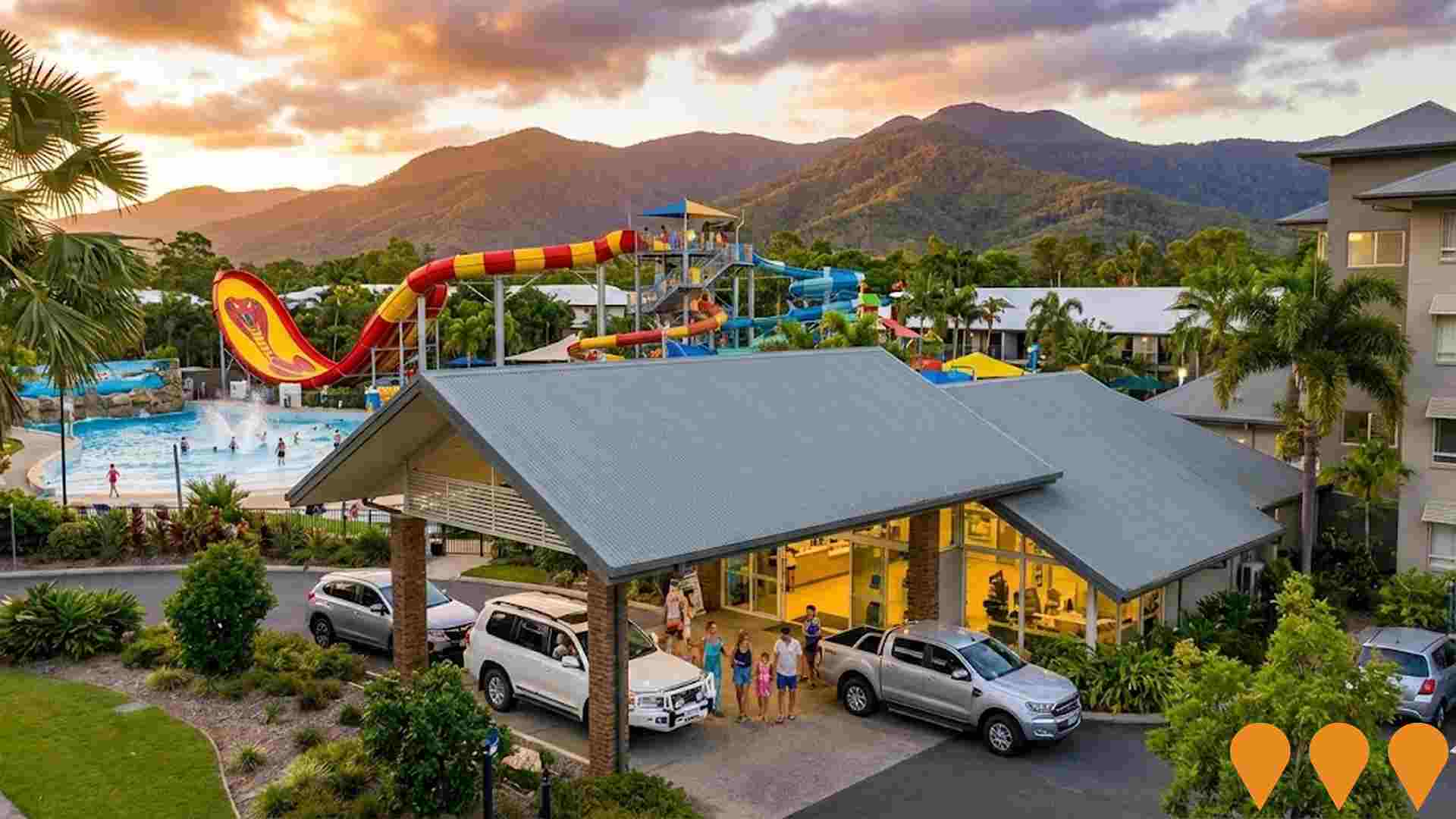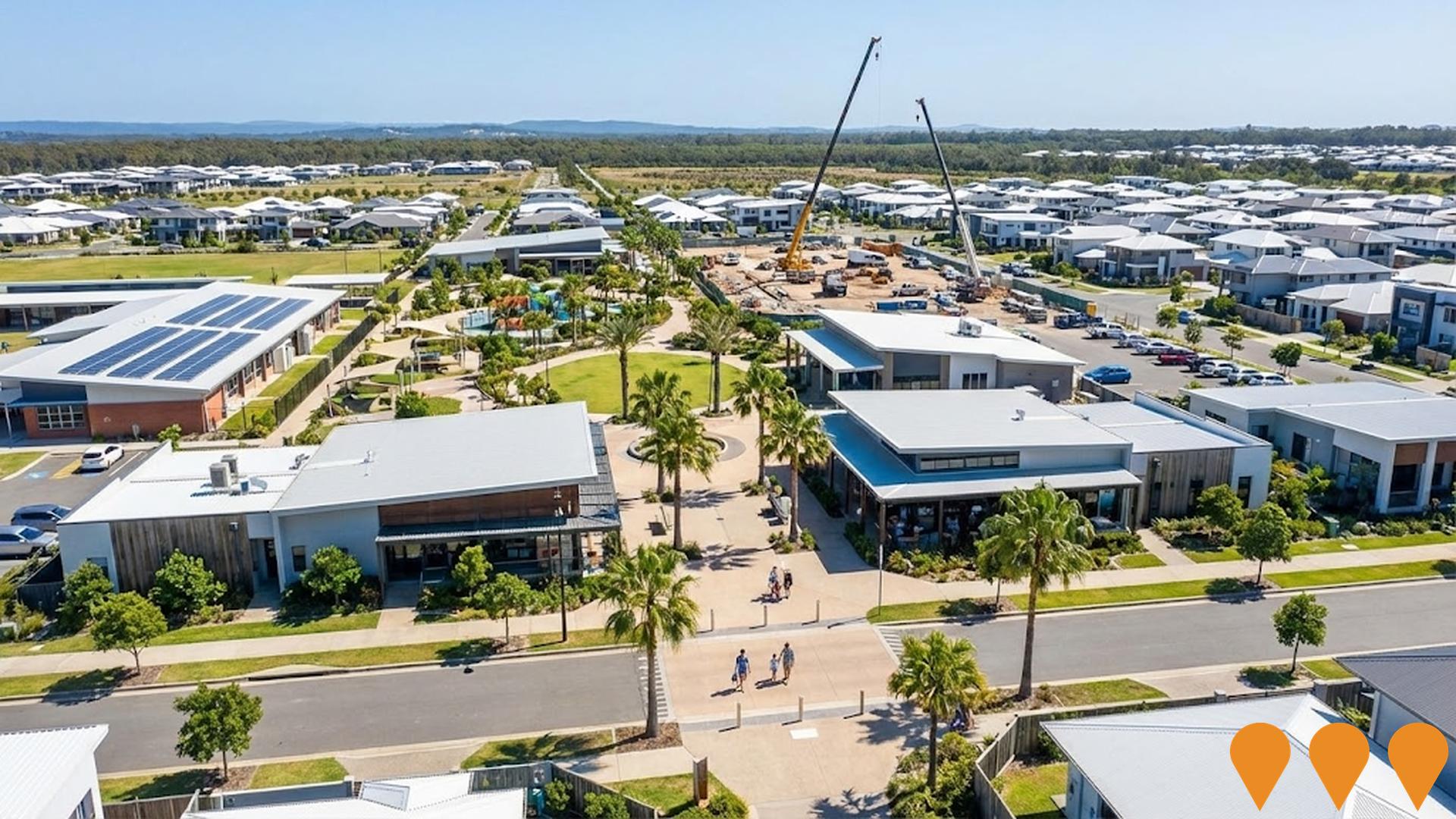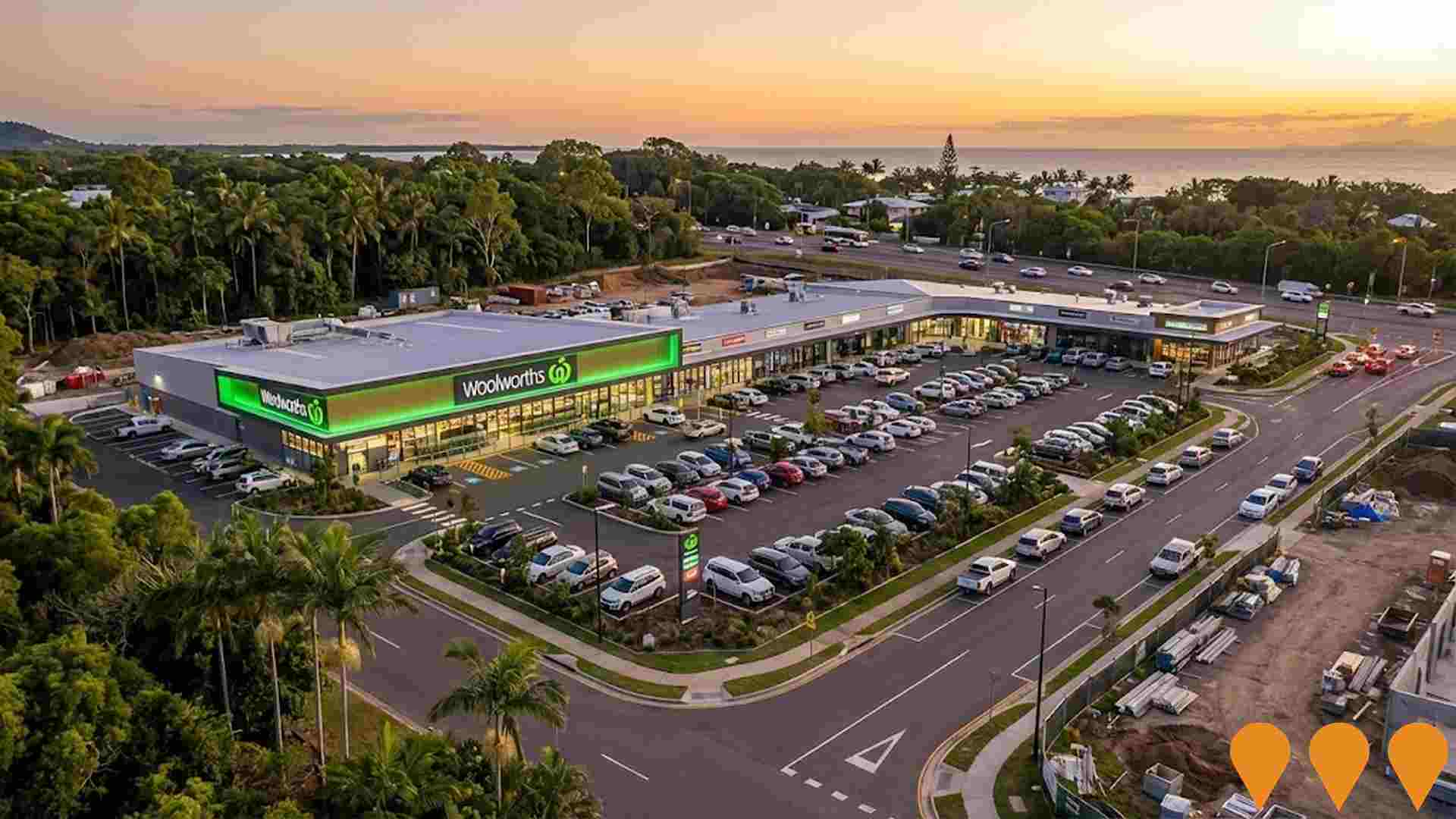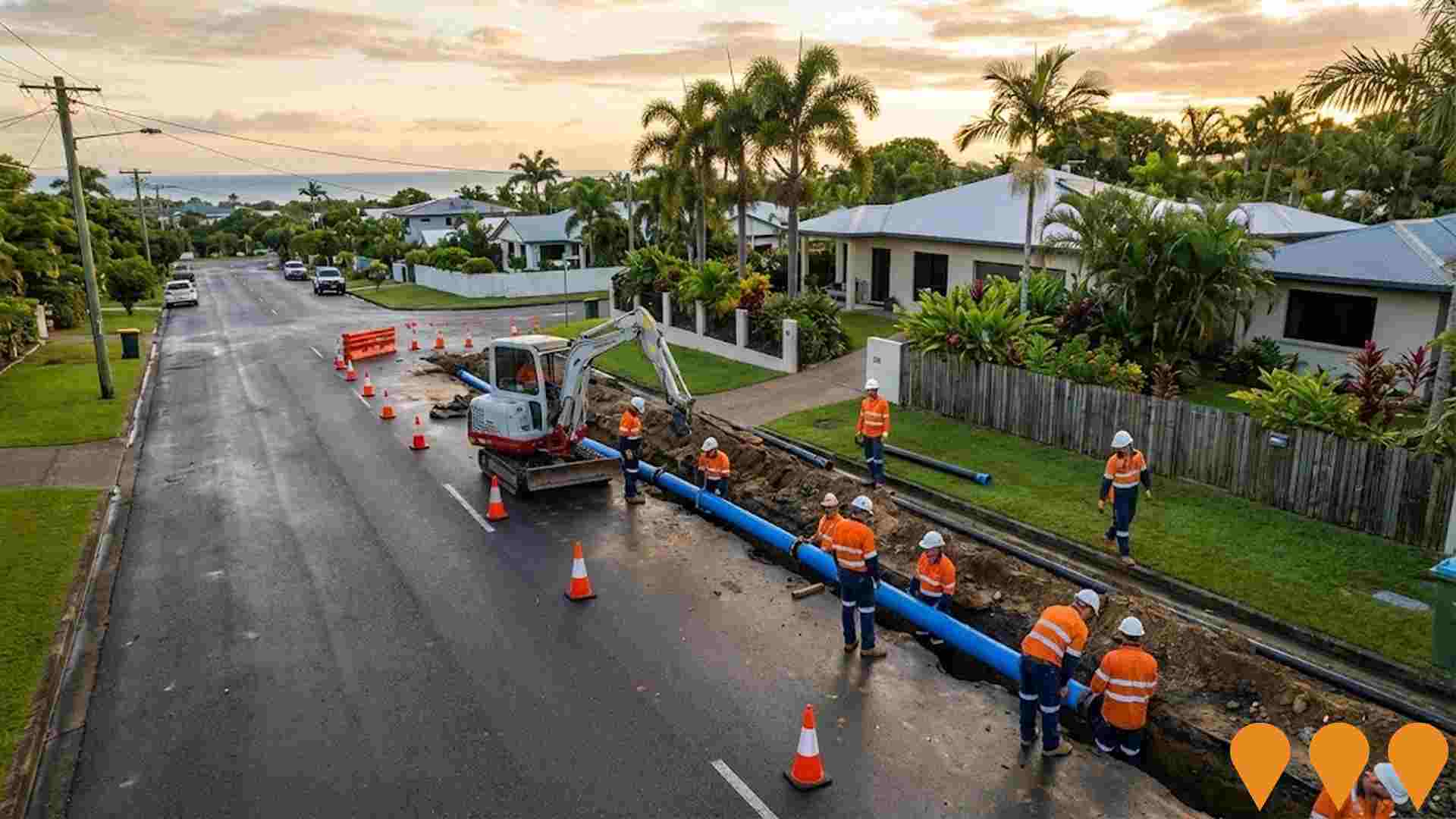Chart Color Schemes
est. as @ -- *
ABS ERP | -- people | --
2021 Census | -- people
Sales Activity
Curious about local property values? Filter the chart to assess the volume and appreciation (including resales) trends and regional comparisons, or scroll to the map below view this information at an individual property level.
Find a Recent Sale
Sales Detail
Population
Population growth drivers in Clifton Beach - Kewarra Beach are strong compared to national averages based on AreaSearch's ranking of recent, and medium to long-term trends
Clifton Beach-Kewarra Beach's population is 12,848 as of August 2025. This shows an increase of 1,059 people since the 2021 Census, which reported a population of 11,789. The change is inferred from ABS estimates showing an estimated resident population of 12,587 in June 2024 and an additional 326 validated new addresses since the Census date. This results in a density ratio of 341 persons per square kilometer. Clifton Beach-Kewarra Beach's growth rate of 9.0% since the 2021 census exceeds both the SA4 region (7.4%) and non-metro areas, indicating strong population growth in the area. Overseas migration contributed approximately 49.7% of overall population gains during recent periods, with other factors such as interstate migration also playing positive roles.
AreaSearch uses ABS/Geoscience Australia projections for each SA2 area released in 2024 with a base year of 2022. For areas not covered by this data and years post-2032, Queensland State Government's SA2 area projections released in 2023 based on 2021 data are adopted. These state projections lack age category splits, so AreaSearch applies proportional growth weightings aligned with ABS Greater Capital Region projections for each age cohort. Future demographic trends project above median population growth for locations outside capital cities. Clifton Beach-Kewarra Beach is expected to grow by 2,200 persons to 2041 based on the latest population numbers, representing a total gain of 15.1% over the 17-year period.
Frequently Asked Questions - Population
Development
AreaSearch assessment of residential development activity positions Clifton Beach - Kewarra Beach among the top 25% of areas assessed nationwide
Clifton Beach - Kewarra Beach has received approximately 79 dwelling approvals per year. Between Financial Year 2021 (FY-21) and FY-25395 homes were approved, with an additional 38 approved in FY-26 so far. On average, 2.1 people have moved to the area annually for each new home constructed over these five years, indicating strong demand that supports property values.
The average expected construction cost of new homes is $457,000, which is below regional levels, suggesting more affordable housing options for buyers. This financial year has seen $2.7 million in commercial approvals, reflecting the area's residential character. Compared to the rest of Queensland, Clifton Beach - Kewarra Beach maintains similar construction rates per capita, supporting market stability aligned with regional trends, although recent activity has increased.
Recent construction consists of 98.0% standalone homes and 2.0% medium and high-density housing, preserving the area's traditional low-density character focused on family homes appealing to those seeking space. Notably, developers are building more traditional houses than the current mix suggests (81.0% at Census), indicating continued strong demand for family homes despite density pressures. With around 114 people per approval, Clifton Beach - Kewarra Beach is a developing area. Future projections estimate an addition of 1,939 residents by 2041. Based on current development patterns, new housing supply should meet demand, offering favorable conditions for buyers and potentially facilitating population growth beyond current projections.
Frequently Asked Questions - Development
Infrastructure
Clifton Beach - Kewarra Beach has moderate levels of nearby infrastructure activity, ranking in the top 50% nationally
Changes in local infrastructure significantly affect an area's performance. AreaSearch has identified 29 projects that could impact this region. Notable ones are The Palms Collection Masterplan, Reefsedge Resort & Waterpark, The Palms, and Breakwaters - Clifton Beach Erosion Management. The following list details those most relevant.
Professional plan users can use the search below to filter and access additional projects.
INFRASTRUCTURE SEARCH
 Denotes AI-based impression for illustrative purposes only, not to be taken as definitive under any circumstances. Please follow links and conduct other investigations from the project's source for actual imagery. Developers and project owners wishing us to use original imagery please Contact Us and we will do so.
Denotes AI-based impression for illustrative purposes only, not to be taken as definitive under any circumstances. Please follow links and conduct other investigations from the project's source for actual imagery. Developers and project owners wishing us to use original imagery please Contact Us and we will do so.
Frequently Asked Questions - Infrastructure
The Palms Collection Masterplan
A major $300 million mixed-use masterplan transforming the former Paradise Palms Golf Course into a sustainable community and tourist destination. The development includes a 330-lot (or 438 total lots across the masterplan) residential subdivision, a land-lease retirement village with 349 sites, a Catholic primary school, and the 'Reefsedge' tourist park featuring the approved $210 million water park, cabins, and a village hub. The project is an EnviroDevelopment certified project and is currently under construction for some stages.

Reefsedge Resort & Waterpark
State-of-the-art waterpark and luxury resort with ensuite caravanning and camping options on the former Paradise Palms site. Council approvals granted August 2024; infrastructure charges concessions confirmed July 2025 with construction indicated to commence shortly thereafter. Features include a three-level slide tower, King Cobra slide, wave pool, lagoon pool, upgraded clubhouse, 138 villas and 127 ensuited caravan sites. Target opening Easter 2027.

The Palms
The Palms is a masterplanned community redeveloping the former Paradise Palms Golf Course into a mixed-use precinct featuring premium residential lots, a retirement village, a primary school, a village hub with retail, dining, and community facilities, and the Reefsedge Waterpark & Tourist Park as a key attraction. As of 2025, construction is progressing with roadworks commencing in June and waterpark construction starting soon.

Trinity Beach Shopping Centre
A brand new shopping centre anchored by a full-line Woolworths supermarket with approximately 15 specialty retailers, including retail, service, medical, and dining options, providing essential shopping services to the northern beaches community in Cairns. The centre features abundant on-grade parking and serves an affluent trade area with strong population growth.

Woolworths Shopping Centre Trinity Beach
New $60 million Woolworths shopping centre development for the Cairns Northern Beaches area. The centre will include a full-line 3800sqm Woolworths supermarket, approximately fifteen speciality stores and services, and 267 car parks. Construction is aimed to start in early 2026 and is expected to take 15 months. The development is on a site at the corner of Trinity Beach Drive and Navigation Rd, adjacent to the Captain Cook Highway.

Northern Beaches Water Network Upgrade
Council's 10-year program (circa $31m) to install and replace trunk and distribution water mains across Cairns' Northern Beaches to improve flow, reduce breakages, and increase reliability for about 34,000 residents. Staged delivery: Stages 1-5 completed (2015-2020), Stage 6 Kamerunga Road underway, Stage 7 Trinity Beach mains and booster station planned by Dec 2026, Stage 8 Paradise Palms to Clifton Beach trunk main planned by Jun 2032.

Breakwaters - Clifton Beach Erosion Management
Construction of three shore-connected rock breakwaters along Arlington Esplanade to trap northward-moving sand and reduce long-term erosion at Clifton Beach. Works scheduled across May-October 2025 with sand nourishment following completion.

Northern Beaches Catholic Primary School
New Catholic primary school proposed within The Palms (former Paradise Palms) masterplanned precinct at Kewarra Beach to cater for growing Northern Beaches enrolments. The Diocese of Cairns has contracted land within the estate and signalled intent to open subject to funding and approvals. Timeline has shifted from an initial hope of 2025; project remains in planning pending formal approvals and delivery program.

Employment
AreaSearch analysis reveals Clifton Beach - Kewarra Beach significantly outperforming the majority of regions assessed nationwide
Clifton Beach - Kewarra Beach has a skilled workforce with notable representation in essential services sectors. As of June 2025, the unemployment rate is 1.7%.
In this month, 6845 residents are employed while the unemployment rate is 2.2% lower than Rest of Qld's rate of 3.9%. Workforce participation stands at 61.3%, slightly higher than Rest of Qld's 59.1%. Dominant employment sectors include health care & social assistance, accommodation & food, and retail trade. The area has a particularly high concentration in accommodation & food, with employment levels at 1.5 times the regional average.
However, agriculture, forestry & fishing has limited presence, accounting for only 1% of employment compared to the regional average of 4.5%. An analysis of SALM and ABS data over a 12-month period shows a decrease in labour force by 1.6% and employment by 2.0%, leading to an increase in unemployment rate by 0.5 percentage points. In contrast, Rest of Qld experienced employment growth of 1.8% and labour force growth of 2.0%. National employment forecasts from Jobs and Skills Australia, released in May 2025, project a national employment expansion of 6.6% over five years and 13.7% over ten years. Applying these projections to Clifton Beach - Kewarra Beach's employment mix suggests local growth of approximately 6.7% over five years and 13.7% over ten years.
Frequently Asked Questions - Employment
Income
Income levels align closely with national averages, indicating typical economic conditions for Australian communities according to AreaSearch analysis
AreaSearch aggregated latest postcode level ATO data released for financial year ended 30 June 2022. Clifton Beach - Kewarra Beach had median taxpayer income of $54,441 and average income of $66,314. Nationally, median income was $50,780 and average was $64,844. By September 2025, estimated median income would be approximately $62,057 and average $75,591, based on Wage Price Index growth of 13.99% since financial year ended 30 June 2022. According to the 2021 Census, household, family, and personal incomes in Clifton Beach - Kewarra Beach ranked modestly, between 44th and 52nd percentiles. Income distribution showed that 34.0% of locals (4,368 people) fell into the $1,500 - $2,999 category, similar to surrounding regions at 31.7%. Housing affordability was severe, with only 84.2% of income remaining, ranking at the 45th percentile. The area's SEIFA income ranking placed it in the 6th decile.
Frequently Asked Questions - Income
Housing
Clifton Beach - Kewarra Beach is characterized by a predominantly suburban housing profile, with above-average rates of outright home ownership
Clifton Beach - Kewarra Beach had 81.1% houses and 18.9% other dwellings in its dwelling structure as of the latest Census. This compares to Non-Metro Qld's 80.8% houses and 19.2% other dwellings. Home ownership in Clifton Beach - Kewarra Beach was 35.6%, with mortgaged dwellings at 37.0% and rented ones at 27.5%. The median monthly mortgage repayment was $1,733, aligning with Non-Metro Qld's average. The median weekly rent was $400, compared to Non-Metro Qld's $390. Nationally, Clifton Beach - Kewarra Beach had lower mortgage repayments at $1,733 versus Australia's $1,863, and higher rents at $400 against the national figure of $375.
Frequently Asked Questions - Housing
Household Composition
Clifton Beach - Kewarra Beach has a typical household mix, with a lower-than-average median household size
Family households constitute 73.7% of all households, including 25.3% couples with children, 36.9% couples without children, and 10.6% single parent families. Non-family households comprise the remaining 26.3%, with lone person households at 23.0% and group households making up 3.4%. The median household size is 2.4 people, smaller than the Rest of Qld average of 2.5.
Frequently Asked Questions - Households
Local Schools & Education
The educational profile of Clifton Beach - Kewarra Beach exceeds national averages, with above-average qualification levels and academic performance metrics
The area's educational profile is notable regionally, with university qualification rates at 25.8% among residents aged 15+, surpassing the Rest of Qld average of 20.6% and the SA4 region's rate of 21.1%. Bachelor degrees are most common at 16.8%, followed by postgraduate qualifications (6.5%) and graduate diplomas (2.5%). Vocational credentials are prominent, with 40.9% of residents aged 15+ holding such qualifications - advanced diplomas at 13.6% and certificates at 27.3%.
Educational participation is high, with 27.5% of residents currently enrolled in formal education: 9.7% in primary, 7.9% in secondary, and 4.2% in tertiary education. Northern Beaches Catholic Primary School and Trinity Anglican School - Marlin Coast Campus serve a total of 0 students, focusing exclusively on primary education with secondary options available nearby. Clifton Beach - Kewarra Beach has no schools, requiring residents to travel for educational services. Note: where schools show 'n/a' for enrolments, please refer to the parent campus.
Frequently Asked Questions - Education
Schools Detail
Nearby Services & Amenities
Transport
Transport servicing is low compared to other areas nationally based on assessment of service frequency, route connectivity and accessibility
Clifton Beach - Kewarra Beach has 44 active public transport stops, all of which are bus stops. These stops are served by three different routes that together facilitate 382 weekly passenger trips. The area's transport accessibility is considered good, with residents on average located 375 meters from the nearest stop.
Across all routes, buses run approximately 54 times a day, resulting in about eight weekly trips per individual stop.
Frequently Asked Questions - Transport
Transport Stops Detail
Health
Clifton Beach - Kewarra Beach's residents are healthier than average in comparison to broader Australia with a fairly standard level of common health conditions seen across both young and old age cohorts
Clifton Beach - Kewarra Beach residents have a relatively positive health profile, with common conditions seen across both young and old age groups at a standard level.
Private health cover is held by approximately 52% of the total population (~6,732 people), which is slightly higher than the average SA2 area. The most prevalent medical conditions are arthritis (8.0%) and mental health issues (7.6%), while 69.7% of residents report no medical ailments, compared to 73.1% in Rest of Qld. The area has a higher proportion of seniors aged 65 and over at 22.6% (2,902 people), compared to the Rest of Qld's 16.7%. Health outcomes among seniors are strong, performing better than the general population in health metrics.
Frequently Asked Questions - Health
Cultural Diversity
Clifton Beach - Kewarra Beach was found to be more culturally diverse than the vast majority of local markets in Australia, upon assessment of a range of language and cultural background related metrics
Clifton Beach-Kewarra Beach had higher cultural diversity than most local markets, with 11.0% speaking a language other than English at home and 31.3% born overseas. Christianity was the predominant religion, comprising 44.8%. Judaism was slightly overrepresented at 0.3%, compared to 0.2% regionally.
Top ancestry groups were English (31.9%), Australian (21.4%), and Irish (8.4%). French (0.9%) and Welsh (0.8%) were notably more represented than the regional averages of 0.7% and 0.6%, respectively, while Hungarian was slightly higher at 0.4%.
Frequently Asked Questions - Diversity
Age
Clifton Beach - Kewarra Beach hosts an older demographic, ranking in the top quartile nationwide
Clifton Beach - Kewarra Beach has a median age of 47 years, which is higher than Rest of Qld's median age of 41 years and the national norm of 38 years. The 55-64 age cohort is notably over-represented in Clifton Beach - Kewarra Beach at 16.2%, compared to the Rest of Qld average, while the 25-34 age cohort is under-represented at 9.8%. Between 2021 and present, the 15-24 age group has increased from 8.6% to 10.0% of the population, while the 45-54 age cohort has declined from 15.7% to 13.5%. By 2041, demographic modeling projects significant changes in Clifton Beach - Kewarra Beach's age profile. The 25-34 age cohort is projected to expand by 415 people (33%), from 1,255 to 1,671. Conversely, population declines are projected for the 5-14 and 15-24 age cohorts.

